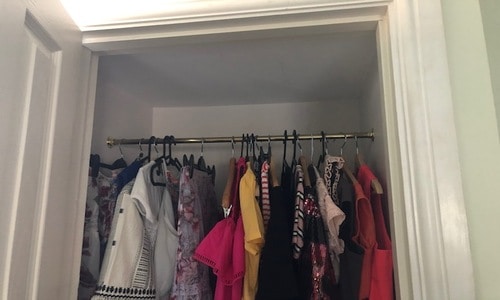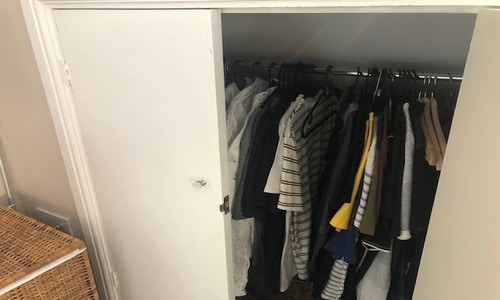Discovering mold in your closet amidst your expensive collection of clothes, shoes, jewelry, and off-season goods can be disheartening. So, how can you remove any mold that’s already present, and how do you keep mold out of the closet for good after?
Here are some mold prevention tips for closets:
- Generate airflow
- Add more light
- Store only dry clothes
- Keep it clean
- Try an air purifier
- Check for signs of leaks
- Use silica packs
- Let your closet breathe
- Consider removing carpet
In this guide to mold in closets, we’ll discuss how to identify mold, the causes of it in closets, and how to kill the mold before it becomes a serious problem. Keep reading for lots of great information.

Signs of Mold in a Closet
Whilst spotting mold formation can be easy on ceilings and walls, closets can be a little tricker. They are usually a lot smaller, and darker, so you might have to take a closer look to identify if you actually do have mold building up.
Here are a few of the ways that you can tell if mold is growing in your closet.
Colored Spots on the Floor or Walls
You should be able to clearly distinguish whether those spots on the carpeting, floors, or walls belong in your closet or not.
Mold isn’t always black, white, or green, although those are common colors. Keep your eyes peeled for mold in hues like red, yellow, gray, or even pink.
The textures are often a dead giveaway as to whether it’s mold growth or a stain, look out for fluffy textures, and circular patterns of black or varying colors.
The Closet Always Feels Warm
When you open your closets, you only expect to be greeted by warm air in the summertime. During any other season, if the closet feels warm upon opening the doors, that’s a sign that the humidity in the closet is higher than it should be.
If you don’t yet see mold, then it’s only a matter of time before you will.
A Constant Musty Odor
The terrible aroma of mold is one that’s likened to earthy mustiness and even smelly socks.
The musty odor may always linger in your bedroom or hallway, but pay close attention if you begin to notice the scent becoming stronger. The bigger the mold buildup, the greater the intensity of smell you can expect.
What to Do About Black Mold in a Closet?
Black mold is a scary sight in any closet, especially since it’s nicknamed toxic black mold.
Fortunately, removal can be swift with common household products such as distilled white vinegar.
Transfer the white vinegar into a spray bottle for easier application and coat the moldy surfaces in the liquid.
Allow 30 minutes to elapse, and then use a clean sponge to scrub the mold.
Wipe down the walls or floors with water and then blot the surface dry with a rag or towel.
How to Remove White Fuzzy Mold in Your Closet
If your closets have lighter-colored surfaces, then you could have easily missed the white, fuzzy mold that has propagated here.
Now that you’ve discovered it, you must remove it, but how?
The white vinegar method as detailed above is effective.
For a heavier-duty solution, try this method.
- Dilute a cup of bleach in a gallon of water
- Apply the solution to the affected area and leave to sit for 15-20 minutes
- Using warm water, gently wipe away the mold with a cloth or rag
- Dry the wall or leave it to air dry completely before putting your clothes back in
It is worth noting, however, that you should be careful with this method.
You’ll want to wear throwaway clothes that can get stained, as if bleach splashes on you, it will permanently stain your garments.
To that end, be sure to take the contents of your closet out so they don’t get bleach-stained.
Wear rubber gloves and goggles and ventilate the room as best you can.
You’ll also want to remove all clothing and wash it before beginning the cleaning process, as they are likely to smell damp and musty.
You may need to repeat this process several times before the mold is completely gone, and if you continue to have a mold problem after several weeks, you may need to look into preventative measures to stop it from growing in the first place.
How to Prevent Mold in a Closet

Keeping mold out of the closet is not merely a one-and-done solution.
You can kill the current mold, but if the conditions in your closet continue to be favorable for mold, then more will appear where you removed the last spores.
The following prevention tips will keep your closet mold-free for good.
Promote Airflow
The humid, stagnant air of a dark, damp closet is a proven contributor to mold, so you must ventilate the space.
Installing a passive ventilation vent like in your bathroom will take the warm air that naturally accumulates and redirect it to the attic.
This project will require very little DIY expertise and simply involves placing a small vent into the wall of the closet to allow fresh air in and stale air out.
Provide Light
If sunlight can ward off mold, then artificial lighting should be an effective solution as well.
Rather than always keep a light on in your closed closets, which is wasteful and will result in a higher electricity bill, consider installing some small windows instead.
Even a skylight would be effective.
Put Clothes Away Dry
You wouldn’t want to wear damp clothes, so don’t put them in your closet that way.
Always spin your clothes through the dryer after washing them or allow them to fully line-dry.
You’ll know your clothes are ready to go in the closet when they feel completely dry from top to bottom. If you feel any damp spots, then hold off on storing the garments in the closet until they’re drier.
If you’re using dry-cleaning bags for clothes storage, stop doing that. The bags trap in humid air and can leave your clothes a moldy mess fast.
Clean the Shelves
The cleaner your closet, the easier it is to identify a potential mold problem. Make it a habit to clean your closet at least once every season.
You’ll have less work to do each time you clean since you’re doing it more frequently, and you can always stay on top of your mold issue.
Use an Air Purifier
High-efficiency particulate absorbing or HEPA filters in an air purifier will remove airborne mold spores and possibly smoke and pet hair as well.
Most air purifiers are tabletop devices that you can easily tuck into a shelf of your closet, but larger models for heavier-duty air purifying are out there as well.
Do keep in mind that the larger the air purifier, the heavier the expense and the bigger the filter you need to exchange or replace periodically.
Check for Leaks and Moisture
It’s worth hiring a professional to come out and inspect for leaks from your attic or other parts of your property that are allowing moisture to seep in. If even a very small leak is detected, and it is allowing moisture to build up in your closet, it will need to be fixed, or your mold problem will not go away.
You might think that your closet being enclosed is simply all that’s causing your mold issue when that could be only half the problem.
Use Silica Packs
A rather unconventional but effective method for drying out mold in the home is to use silica packets like those you find in new clothes, shoes, or handbags
Silica gel is a drying agent that also dehumidifies, and that includes the air.
Besides lessening mold and mildew, storing silica gel around the house can reduce food spoilage and the corroding and rusting of metal surfaces.
Air Out Your Closet
Even with the above measures in play, it’s still wise to open your closet from time to time for more than a minute and let the space breathe.
On a weekend or an evening when you’re home, open the closet for an hour or two to let the air in your hallway or bedroom mingle with the warmer air of the closet.
Remove Carpeting
Are your closets carpeted?
Carpeting can easily become damp and thus turn into a new mold breeding ground in your closet.
It’s worth highly considering tearing out the carpets in the closet. Bare floors can still grow mold, but usually not at the same rate as carpeted floors.
Will a Dehumidifier Work in a Closet?
If you can’t find an air purifier that’s the appropriate size for your closet, as an alternative, you should use a dehumidifier instead.
As the name of this device implies, a dehumidifier dries out the air in a space, be that a room or your moldy closet.
You needn’t purchase a large humidifier, especially for a small space like a closet.
Be sure to run the dehumidifier consistently.
If you don’t use it, then the closet could naturally become more humid, and soon thereafter, mold will grow on the floors and walls.
How to Prevent Mold on Shoes in a Closet
When fungi spread to your shoe collection, you might not know what to do. You haven’t the room to store your shoes elsewhere, so that means busting the mold at the source.
It’s silica gel to the rescue in this scenario as well. Place one packet in each of your shoes that has become green or black with mold.
If you have a couple of extra packets remaining, insert them into the pockets of your favorite garments to prevent the clothes from getting moist enough for mold.
In the future, dry out your shoes fully before storing them in the closet.
Why Are the Clothes in My Closet Damp?
You know you ran your clothes through the dryer before you stored them in your closet, yet a day or two later when you go back in, the clothes feel damp. What’s the rationale behind this?
It all goes back to the quick rise in humidity caused by closing your closet doors without any form of airflow. The humidity builds, causing condensation throughout the room that can leave your clothes looking and feeling soggy.
Consider lowering the overall humidity levels in your home by installing bathroom and kitchen extractor fans, and ventilation grilles and keeping windows open on warmer days to increase airflow.
If your wardrobe or closet is situated next to a colder part of the property, such as a poorly insulated brick wall, condensation will naturally gather here, and your dark, humid closet is the perfect place for mold to grow.
Is Mold in a Closet Dangerous?
Is mold in a closet something you can ignore or could the spores be hazardous to your health?
It’s the latter, especially if your mold issue is in a bedroom closet, and even more so if you have family members with preexisting health issues.
Mold allergy sufferers and asthma sufferers will find that their symptom severity ramps up the most.
The spores can spread, so it’s not even a matter of staying out of the room with the mold.
Even if you and your family have healthy lungs, breathing in mold is still anything but good for your body.
You could develop symptoms such as dizziness, headache, postnasal drip, congestion, itchy eyes, and skin irritation.
Skin infections such as sporotrichosis–which causes purple, red, or pink skin bumps–are also possible.
Conclusion
Mold in a closet may be common, but it’s anything but acceptable. Now that you know what causes mold, how to treat it, and–most importantly–how to prevent its recurrence, you can enjoy a safer and happier home.

